At one point in time, perhaps a decade ago, I had about 200 species and cultivars of Sempervivum and Jovibarba. The idea was to create a patchwork quilt garden of colorful semps. But of course, with my ridiculous schedule, my potted semps eeked out a meager living in pots too small, languishing frrom utter neglect, and sadly I lost many (most) of them over the years, and some that I still do have the labels are lost or worn off... grrrrrr.
A few years ago an offset from a tray of potted Sempervivum cultivars dropped off into a gravel "drip strip" under the roof overhang, the semp doing very well there and growing into a pretty clump. But I don't what which one it is, although I seem to recall a red ciliate one called 'Maigret', maybe that is its name.
Comments
Re: Sempervivum
I don't have a summery pic of Maigret, but this is what I have in early May. The pot is 2.5 inch, so the chicks are quite small. could easily be a match. As you know, coloring and form changes so much with the season.
Re: Sempervivum
I also have Bronco purchased from Betty Ann's Rice Creek Gardens here in MN about 10 years ago. The type I have is like your original. All three pics are taken in May.
Re: Sempervivum
Here's what I have as 'Bronco'... sounds like it matches, more or less, the hybridizer's description that you posted:
Re: Sempervivum
Thanks everyone for helping to confirm IDs on my two semps. Looks like some of you are semp fans too! I updated my 'Bronco' photo with a new photo today, and the sneaky feeling that I goofed up, and planted a similar named cultivar ('Brock') with my 'Bronco'. These plants are truly chameleon plants, you'd almost need to photograph them monthly, to get a sense about what they look like at any give time. And then, change their environs slightly (soil, exposure, etc) and they'll grow and color differently too.
Re: Sempervivum
I plant lots of Sempervivums and other succulents at my cottage. They grow in nothing but cracks in the rock. Sorry no pictures yet. And as you say Mark, they change color but the level of light counts most. As usual I have no labels either so I don't know the cultivar names. I am deeply impressed by all of you taking care of all the labels!
Re: Sempervivum
I am deeply impressed by all of you taking care of all the labels!
I don't like seeing exposed labels in the garden, so I don't keep them at all. I just make maps, and keep a master list.
Re: Sempervivum
I am deeply impressed by all of you taking care of all the labels!
I don't like seeing exposed labels in the garden, so I don't keep them at all. I just make maps, and keep a master list.
I agree with that sentiment Lori, but I'm afraid I do have a "label graveyard" going on here. I used to make maps, but they get out of date, and I can lose my maps as well, then I need a map to find my maps :o ;D
Re: Sempervivum
I tried to make files but got tired of the writing! Startet in "the old days" with a shoebox etc. Maybe I had done better with using a camera and laptop. Instead of writing I tried to remember but you know as Kelaidis is saying, forgetting plant names in 50 years! Sometimes I have labels but the blackbirds pick them faster than I can replace them!
I know the value of a correct name especially when discussing plants in a forum like this. When I hunt for plants or seed I always look for labels and hope they are right (often they are not!).
Re: Sempervivum
I also used to map gardens. Now I keep a list of the plants I have in each garden as well as a master list, as well as labels (usually hidden) with the plants. Keeping track of my plants, with provenance and other pertinent notes was the reason for me getting my first computer. Understanding the rudiments of the Excel program was one of the first things I learned.
Re: Sempervivum
I also used to map gardens. Now I keep a list of the plants I have in each garden as well as a master list, as well as labels (usually hidden) with the plants. Keeping track of my plants, with provenance and other pertinent notes was the reason for me getting my first computer. Understanding the rudiments of the Excel program was one of the first things I learned.
Rick, it sounds like you have "covered the bases" using all of the above techniques. Having digital photo records certainly helps too. One thing I always try to do, is make two labels (maybe even three) for each plant, one in front and one in back of a plant.
Trond, I also have problems with flocks of noisy NOISY blackbirds, who sometimes have label-pulling parties >:( So, I try to plunge my labels deep, so just the tip shows, less likely to be pulled out by birds, and I always use two labels. I know some gardeners who would put in a normal label but then also "bury" a second label just to one side of a plant, always in the same direction relative to the normal viewing of that plant. The interesting thing about deep "seating" or burying labels, is that they aren't exposed to bright light and pencil labeling remains legible for decades.
Re: Sempervivum
Sempervivum 'Bronco' versus 'Brock'. I think I have both, planted together as shown in my photos above, but I just found both cultivars pictured at Mountain Crest Gardens (they have a good assortment of Semps and Jovibarbas for sale). Now I'm fairly sure which is which in my little semp patch.
Bronco:
http://mountaincrestgardens.com/popup_image.php?pID=78
Brock:
http://mountaincrestgardens.com/popup_image.php?pID=77
Re: Sempervivum
I believe one day I shall take up hybridizing sempervivums, maybe a fun hobby when I retire. Only once I tried my hand at hybridizing, here's a photo showing my cross between two species, S. zeleborii x pittonii. You can see some variation in the rosettes. Since the seed is as small as dust particles, my seedling flat was perhaps 1000 seedlings or more, the problem is how to handle picking out and growing on so many tiny seedlings. So, I took the lazy approach, and potted up 3 or 4 big clumps of seedlings, and only the strongest would survive in their fight for space and light. Not a very scientific approach, but interesting to observe the results.
Why did I pick those two species, well... because they were growing close to each other and flowering at the same time ;D
Re: Sempervivum
If I could only grow one Sempervivum, it would probably be S. ciliosum var. borisii. It grows ultra tight and hummocky, and always fresh looking. In late fall and winter, the low flat-topped rosettes are densely packed, and those ciliate tufts at the end of each leaf make little points of light on the rosettes. The first photo is taken in mid October, and I think I like it best in its winter guise. Depending on conditions, spring color can take on rich pink coloration.
The second photo shows the plant in mid June, where the rosettes open up and the silver frosting of cilia catches sunlight to make the rosettes glimmer. So far as sempervivum blooms go, some are tall and awkward, weirdly interesting, or ugly depending on your take on such things. But with S. ciliosum, the flowers are held in more compact heads and are an appealing chartreuse yellow color. Since the flowering rosette dies after flowering, this species fortunately rarely flowers, so no worries about overly abundant flowering to ruin an otherwise fine semp clump.
Re: Sempervivum
A sempervivum planter: color transitions
Hey semp fans, I've had a low bowl shaped plastic container planted with 3 semps for the past 4-5 years, and it sits on the lower step of my deck year round, where I get to view it continuously. The amazing thing about semps, is to watch their foliar color transformation, and rosette transformations through the months.
The 3 plants are:
Sempervivum ciliosum var. borisii - upper left, one of the best ever species.
Jovibarba heuffelii 'Torrid Zone' - upper right, a superb descriptively named Bill Nixon hybrid.
Sempervivum 'Nouveau Pastel' - a 1956 hybrid from Nicholas Moore, one of the most unique, a true semp chameleon.
For the winter, the semps "hunker down" and retreat into a compressed winter mode, showing lots of dried remains of past leaves acting as a "ruff" around each rosette. In spring they grow out of the winter mode and start expanding, taking on vivid colors. In Photo 1, the rosettes still show old dead leaves around each rosette. Just a few days later, with abnormal heat and sun here in New England spring 2010, suddenly the rosettes awaken and start taking on some color and rosette expansion (photo 2). Photo 3 shows strong coloring and rosette growth, the amazing chameleon S. 'Nouveau Pastel' is a luscious toffee color, and 'Torrid Zone' is... hot torrid red with inviting green centers. Photo 3a is a side view showing that 'Nouveau Pastel' is one of those semps that forms tall one-sided "reaching" rosettes... 'Torrid Zone' also reaches upwards. In photo 4 taken the end of July, we arrive at the color apex, with some flowering happening (thank goodness not much though)... 'Torrid Zone' is hotter red than ever after losing the cool green center, and 'Nouveau Pastel' is getting so crowded that it accentuates coffee brown centers.
Some semp species and hybrids put out "chicks" on long stolons, and this can be difficult to deal with. These three semp/jovs were selected because of their dense clumping habit with chicks close to the parent.
Re: Sempervivum
Great colour contrast Mark! Semps are such great plants for pots and troughs....I have about 25 selections at the moment. I poke them here and there anyplace I want a little contrast in colour and form.
Re: Sempervivum
Two superbly grown sempervivums displayed at UK plant shows:
Sempervivum 'Lion King', skillfully planted with natural stones.
Photo by Peter Maguire, SRGC UK member, at the Edinburgh and the Lothians Show 2010
http://www.srgc.org.uk/smf/index.php?action=dlattach;topic=5303.0;attach...
Sempervivum ciliosum var. galicicum, displayed at the London Show 2010, looks like a Rebutia.
http://www.srgc.org.uk/smf/index.php?action=dlattach;topic=5303.0;attach...
Re: Sempervivum
The second semp looks almost like a Mammilaria!
I grow mine in rock crevices or at the roof (houseleek you know - takløk (roofleek or rather -onion) in Norwegian).
Re: Sempervivum
The second semp looks almost like a Mammilaria!
Probably because a good number of the rosettes of S. ciliosum var. galacicum in that photo are on the verge of flowering, so they morph into those odd looking "vertical" rosettes. That clump might not look so good after that many rosettes die. :(
Re: Sempervivum
Finally found two photos of my semps, back in the year 2001, seen growing in pots woefully too small for long-term, but the intent was to create new garden beds for my 200 semps in the shorter term, but this never happened, most of the plants slowly suffered and dwindled away over the years. The photos taken in July, show that many take on their brightest colors in midsummer.
I was also made aware of a URL of a German sempervivum nursery web site, where you can see good photos of over 300 semp cultivars, then many more of semp and Jovibarba species. I use Google translate in my Internet Explorer 8.0 browser, which really helps.
Re: Sempervivum
Here's some of my "wild" semps.
Trond, you "wild semps" look very natural among rocks. Since I have lost the labels on some of my semps, I too now have "wild semps" :D I do like the tectorum forms very much; classic rosettes.
Re: Sempervivum
Here's an oddity on what is already an oddity... Sempervivum 'Oddity', that is, with a rosette that seems to lack chlorophyll. Bizarre!
Re: Sempervivum
Hi guys!
I grow about twentyfive cultivars all unnamed. They suffer here during the summer months but recover in the fall and early winter. I have been moving starts to shady sights with better results, but haven't taken the time to move all of the older clumps. I have been toying with the idea of planting some at the bases of my cholla cactus. I think they would get enough shade from the branches to keep them from turning pale and losing leaves in our hot summer months.
Re: Sempervivum
Hi guys!
I grow about twentyfive cultivars all unnamed. They suffer here during the summer months but recover in the fall and early winter. I have been moving starts to shady sights with better results, but haven't taken the time to move all of the older clumps. I have been toying with the idea of planting some at the bases of my cholla cactus. I think they would get enough shade from the branches to keep them from turning pale and losing leaves in our hot summer months.
Fortunately I don't need to bring mine into shade although it is a bit dry here in June.
Re: Sempervivum
Trond, a most becoming handsome shot of your flowering semp; shorter more compact stems than many, in proportion to the rosettes, with harmonious colors. Your photo reminds me why I love sempervivum, plants of simple pleasure. :D
Re: Sempervivum
I like Trond's semp too. There are about fifty, maybe more, here. Little ones, medium ones, big ones. I bought so many this spring (again at Timberline, where there are rows upon rows of them) that some haven't been planted yet. I grow them in containers, mostly. Shallow Mexican clay dishes.
They're hybridizing and seeding around like crazy. The seedlings invaded one trough and the very lazy gardener here paid no attention until it was too late.
They cook in full sun in Denver, but they take the heat in stride.
Re: Sempervivum
I like Trond's semp too. There are about fifty, maybe more, here. Little ones, medium ones, big ones. I bought so many this spring (again at Timberline, where there are rows upon rows of them) that some haven't been planted yet. I grow them in containers, mostly. Shallow Mexican clay dishes.
They're hybridizing and seeding around like crazy. The seedlings invaded one trough and the very lazy gardener here paid no attention until it was too late.
They cook in full sun in Denver, but they take the heat in stride.
Funny, I never thought about Sempervivums "cooking" in the sun and heat... I don't treat them as regular desert succulents as they are alpines after all, but I noticed today that a semp in a planter showed its inner leaves to be "fried" and scorched on this 99 F day, so I moved it out of the blazing sun and into some shade... it whispered a sigh of relief.
Re: Sempervivum
I never grow my semps in containers as I have lots of natural cracks in the rock here. (Most of the semps I grow at our summerhouse.) They never get sun scorched either but now it is becoming quite dry so they roll themselves into small balls. We are still waiting for the warm weather we read in the papers that everybody else have (except Todd maybe!).
Re: Sempervivum
Just made a new semp planter, this task taken not because of a design need, but more from an action to salvage some good semps that were sitting and suffering in small pots that haven't been replanted in 6-7 years! The new planter is a very wide but shallow plastic (clay-emulating) dish, which is partially sunk into the ground. Six semps and one Jovibarba were planted, their colors long faded in the late summer doldrums, but I look to next spring and early summer to see the fruits of my effort. Just so you know, the conspicuous plant labels will be removed as soon as I draw a map of the planter. The stone used is native stuff unearthed whenever I dig into our so-called soil, and the stone chips are the same stone that I break up with a hammer to use as a top dressing.
The following were planted.
Refer to photo #2 (overhead view) for the following descriptions:
11 o'clock - S. 'Pacific Devils Food'- nice chocolate color but a difficult grower
12 o'clock - J. heuffelii 'Gold Bug' - ooh, at its peak, a rich golden yellow with red tips, small. One of the best.
1 o'clock - hard to see, a smidgeon of S. arachnoideum 'Album', but hopefully it'll regain a foothold here.
3 o'clock - S. 'Brock' - a medium size but imposing red, it has its showy season earlier in the year.
4 o'clock - S. arachnoideum 'Yukon Snow' - one of the whitest webbiest cobwebby types, nice.
6 o'clock - S. pittonii, a tight growing species with small rosettes & some dark leaf tips. Yellow flowers. Nice.
8-9 o'clock - S. 'More Honey', when at its peak of color, this yellowish amber one is excellent.
Re: Sempervivum
A very nice end product. I hope you were wearing eye protection when making those chips!
And there is your labeled map here on the forum too...
Re: Sempervivum
Looking good, Mark! Perhaps that's what I should do with a couple of my less successful troughs?
Re: Sempervivum
Interesting planting, Mark.
I once saw semps planted on old roof tiles hung on the wall! (The Norwegian name is "takløk" litterally "roof-onion"!)
Re: Sempervivum
Here is the object of my next semp planting, a rusty yet still functional old wheelbarrow. While it has some cracks to provide a bit of drainage, I shall be drilling additional drainage holes. Still not sure of the landscape scenario and placement of this object d'art, but I'm working on it, and hope to find a location and get it planted in a week or so. Will upload pics once planted.
Re: Sempervivum
... And so easy to move if you ever decide to relocate ,,, to north central Alaska! :D
Re: Sempervivum
Sempervivum plantings can of course go hand in hand with other hardy Crassulaceae such as Orostachys. Check out the following link for 10 photos of Orostachys species blooming in Peter George's garden in the fall.
http://nargs.org/smf/index.php?topic=373.msg4641#msg4641
Re: Sempervivum
My recently re-planted Sempervivum pittonii plants are hunkering down for winter, but suddenly changed color, now a blue-green color with red tips, rather nice.
Re: Sempervivum
The rocks you have used are very similar to the rocks I just dug out here. I am going to make a new step and have to remove the old one made of all kind of stones and rocks. But that kind of "rubbish" is always useful.
Re: Sempervivum
The small rocks or "gravel" is the same rock as the larger rocks, just smashed with a hammer to get the finer gravel as a top dressing (yes Rick, with eye protection). I still haven't planted my "wheelbarrow planter" yet, but as I work to lift some sod and expand my gardens slightly, there's always lots more of this rock in the so-called soil here, and I save that rock for planters. This semp is in the same large planter shown in my photos above.
Re: Sempervivum
Today I worked on a wheelbarrow sempervivum planter. It will "live" in a hollowed out part of a hillside, the whole area to have sod removed (too difficult to mow the steep hillside) and the ground "sculpted" with paths and bermed planting beds. The first step was to remove sod and excavate soil at the base of the hillside up to 1' (30 cm) deep or more, to lessen the incline somewhat. The unexcavated edges around it will be broadened, and further rock features and plantings will soften the excavation. A layer of gravel will eventually be laid around the wheelbarrow setting.
1-2 Sod removed, area excavated, excavated rocks temporarily tossed into wheelbarrow. Wheelbarrow positioned.
(note: additional drainage holes were drilled in the metal well of the wheelbarrow)
3-4 Wheelbarrow heaped with sand/loam mix. The fun part, arrange native stone in pleasing formations and plant pockets.
(note: the planter is heavy, but still can be moved. However, the intent is to leave it in place.)
5-10 Wheelbarrow is planted, and top-dressed with the same rock that was hand-crushed; our native rock crushes easily with a hammer, with eye-protection of course. I like the fact when crushing the rock, one can purposely make various grades of chippings, large to small, and even some fine particles. When planting this late in the season, the semps are mostly already hunkered down and ready for winter, and only showing green, so not overly showy at the moment. Also, there are more pockets that need planting; I was running out of daylight.
When I place the rock, I like mixing rock sizes, and I try to create some noticeable height to the planter (see side view). I also like to have some rocks extend out and over the planter edge.
There will be no labels in this planter, I created a map instead. But I will also use a digital photo marked up with plant names as my guide. Some of the semp plants are ones for which the labels either disappeared or wore off.
Sempervivum 'Fame Montrose' nomenclature
Several years ago I saw for the first time the sempervivum called 'Fame Montrose'. Since then I have acquired two plants, one from a commercial source and one from a friend. I've wondered about the name since first seeing the plant. In particular, what is the significance of the 'Montrose' part.
Today I read on-line something which gives me more reason to wonder. I've learned that this cultivar is prone to sport spontaneously back and forth between normal plants and plants which have the truncated, tubular leaves which characterize 'Fame Montrose'.
Was there/is there a cultivar called 'Fame'? Here's why I'm asking: in the old days teratological (deformed) forms of plants and animals were sometimes described as monstrous.
So is 'Fame Montrose' a misreading of 'Fame Monstrous'?
And if not, can anyone shed some light on the significance of 'Montrose' in the name?
Here's a link to an image of one of my plants:
http://mcwort.blogspot.com/2011/04/sempervivum-fame-montrose.html
Jim McKenney
Re: Sempervivum
When dealing with Cacti the term "Monstrous" deals with abnormal, distorted and disfigured growth of the body, not the apex. A mutant growth form often resembling a club-like shape in cylindrical or columnar cacti and a wavy body shape in cacti that have pads. "Monstrose" and "Monstrosus" are botanical terms used to describe these growth forms. The general terms, both words mean; like a monster.
Re: Sempervivum
Sorry, nothing to add here, except ... nice web site, and welcome to the NARGS forum, Jim!
I never cared for Oddity, but Montrose Fame is much nicer.
Re: Sempervivum
Echoing what has gone before, welcome to the site, Jim!
I agree, Rick, 'Fame Monstrose' is much nicer than 'Oddity' - the coloration makes it quite interesting.
Re: Sempervivum
There is indeed a cultivar S. 'Fame'
As to the odd offspring, that is a matter of some mystery.... firstly, is it really Montrose or is this a typo for Monstrose?
Certainly the monstrose epithet is applicable to this sport of 'Fame' but I have found a reference to 'Fame Montrose' being having been "Hybridised" by NICHOLAS MOORE (UK), 1962
Montrose is a Scottish coastal town and also the name of an old title in the peerage - Duke of Montrose so it may have been a little joke on the part of the raiser .... we may never know :-\
Re: Sempervivum
Thanks for the replies, everyone, and thanks, too, for the welcome. For now I'll stick to 'Fame Montrose' or maybe " 'Fame Montrose', the monstrous sport of 'Fame' "
I've tried to pull back from participation in the on-line forums because they were (very pleasantly) eating up my life. On top of that, a series of big changes in my garden has left me without much of a garden to speak of. About three years ago things began to fall apart; at first I neglected the little things, then a hurricane took down the pergola (actually a storm took it down first, then no sooner did I get it back up and the hurricane took it down again) , then it was necessary to remove an enormous tree - the place still looks more like a construction site than a garden.
And so while the rest of you are issuing gracious invitations to "come see the garden" I'm dreading the phone calls and the need to explain, again, that my garden is not yet ready for visitors. I'm trying to focus my time and energy into getting the garden back into shape. That means for now a severe cut back in time spent on-line - and it also means (or so he says) that he will not be acquiring lots of new plants this year -well, maybe a few more.
About a year and a half ago my browser spontaneously started to block me from the SRGC site. If I switched to another browser I was able to access the site without a problem. But at the time I did not want to permanently switch browsers, and so I've got a lot of catching up to do at that wonderful site.
To add to my woes (as if this never ending winter were not woe enough) my computer showed signs of dying in January. It was well into February before I began to take action, and the new box did not arrive until mid-March. Now I'm dealing with all the little bothers which arise when one switches operating systems. That resolution to not buy lots of new plants this year will be easy to follow because all the plant money went for the new computer.
Little by little I'm getting closer to where I want to be. But until I get the garden under control, my time on the forums will be limited.
Thanks again, everyone.
Re: Sempervivum
Hello All,
Just read the entire thread, having recently become more interested in Semps, in part being inspired by this photo I came across in the Galleries. I love the massed effect. I'll be ordering from Squaw Mountain Gardens (yes, Mark, they are still in business) because they send a hen (or two) and as many as five chicks for the money, which is usually $3.35, and they have a large selection and good photos. They ship bare-root.
They have S. ciliosum but not var. borisii, that seems hard to find. A seller on eBay has it and they seem like a good source for plants, but they charge $3.45 plus $5.25 s&h for a hen in a pot, and that seems high. They carry 'Fame Monstrose' (sic) and have a great photo here: http://cgi.ebay.com/Fame-Monstrose-SEMPERVIVUM-HENS-CHICKS-/120706752093...
So I'm wondering, is var borisii markedly different from the plain species?
Can anyone recommend varieties that are good or more attractive spreaders? Of course I appreciate the individual rosettes, but right now I'd like to experiment with masses of them, even is they're very small masses to begin with.
Re: Sempervivum
Maggi; thanks for the possibilities on the Fame names... I wonder if there is indeed both a 'Fame Montrose' and a 'Fame Monstrose'?
'Fame Montrose'
http://www.sbohio.com/Photos.php?view=preview&category=16&image=130
'Fame Monstrose' (other monstrose forms, looking very different from each other, go under the same name, see one more below).
http://i16.photobucket.com/albums/b11/wood11/Sempervivums/April2008146Sm...
It's been so many years since Nicholas Moore's and David Ford's profuse introductions of delightful semp cultivars, I fear that some of the ensuing confusion may never be straightened out.
Jim, glad to see you over here on NARGS Forum... it's been relatively quite on Alpine-L, and very quite (surprisingly) on Pizza-L ;D, so I'm glad to made the jump to forumville.
Jeremy, your semp planting is picture prefect, exactly the way semps show off best, stitching together rocks with the neat and colorful rosettes! Inspiring. Maybe bring some to the plant and seedlings sales at NE NARGS meetings ;) Now that I'm back to work (although at a rather reduced salary), I'm burning up with plant-buying fever, but still must reign in these impulses, although semps are so inexpensive that I might just place an order with Squaw Mountain.
Regarding Sempervivum ciliosum var. borisii, in the Sempervivum & Jovibarba Handbook by Peter Mitchell describes var. borisii "Found growing at Pancerevo, Bulgaria... differs from the species in having much longer hairs making the rosettes appear almost white, more so when grown fully exposed".
Recommend varieties that are attractive spreaders: there are so many, including species like erythraeum, pittonii, zeleborii, many others. For a unique color, there is nothing quite like S. 'Nouveau Pastel' which in summer turns a caramel milk chocolate color, and it has tight, neat spreading habit (see photo of it in my round planter, earlier in this topic). Remind me, and I'll bring a couple rosettes for you at a chapter meeting. If one likes the ciliate types, like S. ciliosum var. borisii, there are a whole series of hybrids with it that are really choice, here's a few:
Semp 'Raspberry Ice'
http://www.sedumphotos.net/v/semps-nr/Sempervivum+Raspberry+Ice.jpg.html
Semp. 'Georgette'
http://img.photobucket.com/albums/v119/Crazy_Gardener/sempervivums/014.jpg
Semp. 'Ginnie's Delight'
http://www.sedumphotos.net/v/semps-fm/Sempervivum+Ginnie_s+Delight.jpg.html
Semp 'Shirley's Joy'
http://www.sedumphotos.net/v/semps-sz/Sempervivum+Shirleys+Joy.jpg.html
Semp 'Silver Thaw'
http://www.sedumphotos.net/v/semps-sz/Sempervivum+Silver+Thaw.jpg.html
And, a couple more 'Fame' photos:
Semp 'Fame' (1)
http://www.sedumphotos.net/v/semps-fm/Sempervivum+Fame+_1_.jpg.html
...listed as Semp 'Fame' (2) (a thickened leaf monstrose form), can also be seen in the previous photo. This looks very different than the quilled-leaf form that Jim McKenney shows.
http://www.sedumphotos.net/v/semps-fm/Sempervivum+Fame+_2_.jpg.html
Re: Sempervivum
Spring color is starting to show on some of the semps. Last summer I planted a low dish-shaped planter with sempervivums and our native stone (go back to page 3 of this thread), essentially rescuing some semps and jovibarbas that were nearly lost to neglect and becoming swamped in moss. The transplanted rosettes were all undersized, but already they are looking much better.
On the left is Jovibarba heuffelii 'Gold Bug', one of the more unusual and bright colored cultivars. On the right is another view showing 'Gold Bug' at the top, S. zeleborii on the right, and in the forefront is S. 'More Honey', an apt name for a lovely compact cultivar that goes through many color phases.
Re: Sempervivum
An update on my semp planter, the season is progressing well, and semps and jovibarbas are coloring strongly, the rosettes now expanding and opening up, the chicks just starting.
My wheelbarrow planter is looking good too, although I have too many red-leaf types planted, needs better color variety, so I'm going down to a local nursery tomorrow that typically has a good selection of semps, a few Rosularia, and some hardy "mesembs".
Re: Sempervivum
Mark, the red-leaved ones contrast very nicely with the rocks.
Re: Sempervivum
Both are looking great, Mark!
An ambulatory planting! ;D ;D Excellent concept!
I'll keep an eye out for 'Gold Bug'. I've never seen one like that - very nice!
Re: Sempervivum
Sempervivum octopodes var. apetalum - The name is an apropos description, as its stolons are very long (5+ inches on a vigorous plant) before it sets its new babies. I've had the fingers reach out over two pots before depositing its offspring in the third. You can imagine how a single rosette with these long "tentacles" would look very much like an octopus.
This is a December photo:
I am not always a fan of green flowers, but I do like this one. Flowering now:
Re: Sempervivum
I like that one too. That's an amazingly early bloom, or is your season that different from here?
Re: Sempervivum
It is very early, but that is normal for the species according to the literature. The next sempervivum to bloom that I have(had) is another ciliate type, 'Maigret', and it will be another week and a half to two weeks yet. (I donated that 5 inch potful to the Chapter sale.)
The biggest difference, I think, between our climate timing is that we have a very compressed spring, and leap right into summer quickly. Three days ago we had a 101 F day! Most years, we don't even reach 100 degrees all summer long. It has changed the growth pattern of several plants. Lilium szovitsianum infolorescence are very compact and only half as big as they should be, but still will the same number of flowers.
Re: Sempervivum
The biggest difference, I think, between our climate timing is that we have a very compressed spring, and leap right into summer quickly. Three days ago we had a 101 F day! Most years, we don't even reach 100 degrees all summer long. It has changed the growth pattern of several plants. Lilium szovitsianum infolorescence are very compact and only half as big as they should be, but still will the same number of flowers.
We have prolonged springs! They start in February and last to June ;D
101F :o We'll never experience that here (at the coast where I live). If we hit 85F that would be front page stuff.
Re: Sempervivum
I see. Yeah, it doesn't reach 100 deg F here until.... err, well, never in recorded history actually. ;D
Glad to hear your lily will still bloom well despite the hot spring.
Re: Sempervivum
Sempervivum octopodes var. apetalum - The name is an apropos description, as its stolons are very long (5+ inches on a vigorous plant) before it sets its new babies. I've had the fingers reach out over two pots before depositing its offspring in the third. You can imagine how a single rosette with these long "tentacles" would look very much like an octopus.
I am not always a fan of green flowers, but I do like this one. Flowering now:
A species not often seen, I too like S. octopodes, I used to grow it in the days of having a bigger semp collection. Typically I prefer semps with short stolons so that they build into tight mats, but this one makes such a mass of criss-crossing stolons and chicks, that it visually fun. Good cilia too, I'm a fan of ciliolate semps. Google this semp and you'll see lots of good images.
I wonder however about the var. apetalum part, as the variety apetalum "differs from the type mainly by the absence of petals and stamens, also having more numerous sepals". There are a couple good links that describe this species in the wild, as well as describe the variety. My guess is, much of what goes around as var. apetalum is actually the type species S. octopodes.
Sempervivum octopodes on Mt. Pelister, Macedonia
http://stalikez.info/fsm/semp/site/octo_gb.php
http://www.deeproot.co.uk/pbo/plantdetail.php?plantname=Sempervivum+octo...
So far as early bloom on semps, it's not unusually early in this area; with some moisture and warm to hot weather they surge into bloom. Here's one that I lost the label on (might be S. 'Maigret') that is nearly in bloom, taken on June 6, 2011, nearly a week ago.
Re: Sempervivum
I had seen that same original description about the variety before, Mark. In fact I had saved the page on my pc. Frankly, I don't think I could distinguish between petals and sepals for verification, even if I dissected the flower. Also, how it could be a true variety if it doesn't produce stamens (and therefore pollen) for reproduction? So I wonder if that part of the 1929 description is an anomaly. But I also read the rest that same literature quote that is more consistent with my plant:
For var. apetalum
--- "The rosettes are generally larger than these of the type and can reach between 2,5 to 3 cm in diameter" (I have had ones larger than that.)
--- "[leaves] with a less well defined brown marking on the apices." (Depending on the season and care afforded, my rosettes can look like my pic below.)
--- "Offsets are very freely produced on even longer stolons than the type, up to 9 cm in length." (As I said, I have had 5+ inches [12+cm])
--- "Unlike the type, this plant withstands the winter damp well and is very easy of culture." (Never had any hint of a cultural problems here, for the four winters that I have grown it. It's as easy as any semp.)
Obviously, I've been wrong before; what do you (or anyone) think?
Edit: Further study has me convinced that I have the type species, not the variety apetalum.
----------------------------------------------------------
That 101 F day was really freaky, and very windy. It was like being in a windy, dry sauna all day. Like when you're in the sauna and blow on yourself, and it feels hotter rather than cooler. Weird for us northerners. Fortunately, it was only one day - 85 F the day before, 75 the day after. But blooms really took it hard and withered rapidly. Out of many, I have one promising seedling from Iris setosa 'Tourist': saw it opening at 5:30am when I went to work, and it had shriveled by the time I got home.:(
Re: Sempervivum
A very nice one, Trond. It has flaming leaf tips!
Another thing I have noticed about S. octopodes: when it flowers, the stem always looks as though it is dying prematurely, even before it has finished flowering. This time I am going to let it go to seed and see what happens...
Re: Sempervivum
Those seem to be a lot longer and more clasping leaves along the stems than what I am used to, Trond.
I like it.
Various photos of Sempervivum arachnoideum 'Minus':
An early November shot. That's it to the left of Pediocactus simpsonii.
Late April:
I like how the colony builds in irregular height.
Late June:
Re: Sempervivum
Some fine cushions, Rick! Are you a fan too?
I do grow a few at my summerhouse together with Sedum and other drought resistant plants. (Boat house in background)
Re: Sempervivum
lots of lovely plants, everyone! I've been taking tons of photos of my plants, and almost keeping up editing them, but no time left to post after that!
Here is a small series of some plants I received in 2009 from a European collector as tiny offsets of 'lost label' plants; she is a very serious collector, and if she felt they couldn't be named, I wont try! (probably some she knew species and lost clone info, others are doubtless hybrids).. from May 24 this year
I stuck them almost blindly into some group pots to mature- they were etiolated and pale from the mail, so part from seeing some hints of red, I didn't know what I was planting next to what... Now most of the pots are very full and need some divisions, especially where a couple of tiny forms are being overwhelmed!
Keep in mind that colours tend to stay good here all year, at least in recent cold summers, and always with cool nights!
This reddish plant is one of the 'fanciest' forms I have, its just getting going here,from its compact winter form, but all summer shows very interesting markings/banding on the leaves besides good colour..
Group shots..
A couple other nice ones.. the second red is an extra dark one...
Re: Sempervivum
You have some nice potfulls as well, Cohan!
Re: Sempervivum
Thanks, Trond! Some of those pots are really full and I have to take out some really small forms soon as they are being overwhelmed by bigger ones.. and many of the plants are ready to flower this year, after the 2009 plantings--I received two separate sets of pieces that year, one of species and named forms, and one of lost labels, and lots of flowers coming in both sets...
Also my S ciliosum, which was a local purchase in ( I think) 2008, is flowering for the first time, with seven flower stalks currently flowering, and I noticed two more small ones coming! It will be decimated, but it has many many offsets in a small space.. I'll post photos, but I want to put together a series ....
Re: Sempervivum
Your certainly have a nice form of Jobibarba allionii, Cohan. This December pic shows the most color mine ever gets:
Re: Sempervivum
Your certainly have a nice form of Jobibarba allionii, Cohan. This December pic shows the most color mine ever gets:
Thanks, Rick, its a fave for sure-staying tightly closed most of the year, such great form! It's actually a clone with location data; at first I just thought it maintained its tight form and colour due to my chilly weather (which likely still is a factor, as it is with all the semps) but then I realised that in one of my no-name pots there seems to be another allioni, which is paler and looser..
Re: Sempervivum
This little thing is sort of a Sempervivum/Jovibarba ally, I suppose... Rosularia muratdaghensis. (To give a sense of scale, the hairy thread-like things are seeds of Pulsatilla vulgaris and the plants next to it are Sedum acre.) It is supposed to have hairy rosettes (which I suppose it does), and flowers on which the petals are partially fused into a tube (haven't seen it bloom yet).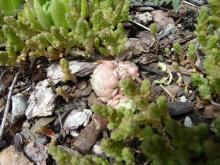

Cohan, you were growing another Rosularia sp., I seem to recall. Did it winter over?
Re: Sempervivum
That looks like a really nice one, Lori! I've seen this on seed lists, don't think I have the seed (I have a couple unsown..)
Yes, I have Rosularia (Prometheum) aizoon, a small clump planted in a pot which has been sunk for winters, in 2009, and its doing great! Slowly expanding its clump of tiny rosettes, no flowers yet.. I may not have photographed it this year yet, if so can't find the shot right now.. I'll take one in the next few days..
Ironically, the piece I kept indoors for insurance has survived but barely, I'll put it outside as well...lol
Meanwhile, for Rick, here is that same Jovibarba allioni (that is, same form, not the same plant, necessarily, I have it in a few spots, all young clusters like this.. not quite as fast as the J globifera hirta I got at the same time) with better spring colour/form, from May 11; this file has the location data in the name..
Re: Sempervivum
Exquisite, Cohan! If you ever get seed...
My allionii have never produced a flower yet, in the seven years I have grown them.
Lori, you grow Sedum acre... in the garden? That, and S. sexangulare are unwelcome weeds here! I do grow a variegated form of S. acre, but only in a trough where I can keep a close watch on it.
Sempervivum flowers can be so similar, but they are so cute!
Sempervivum 'Bronco'
Re: Sempervivum
Lori, you grow Sedum acre... in the garden? That, and S. sexangulare are unwelcome weeds here! I do grow a variegated form of S. acre, but only in a trough where I can keep a close watch on it.
Errr, yes, I guess so... I have assumed that it's Sedum acre but I haven't really paid any attention to it. Does it look like S. acre to you? It does get similar yellow flowers, sparingly. It doesn't have the sexangularity ( ;D) of S. sexangulare. If it is S. acre, I guess the lousy soil and dry conditions are enough to keep it in check, as it has not spread rampantly in the >10 years it's been there. ???
Re: Sempervivum
Exquisite, Cohan! If you ever get seed...
My allionii have never produced a flower yet, in the seven years I have grown them.Lori, you grow Sedum acre... in the garden? That, and S. sexangulare are unwelcome weeds here! I do grow a variegated form of S. acre, but only in a trough where I can keep a close watch on it.
Sempervivum flowers can be so similar, but they are so cute!
Sempervivum 'Bronco'
[attachthumb=1]
I have some bits of what I presume to be S acre that came in a mixed pot of small sedums, still in some small pots sunk for winter, and in my big mixed pot... no spreading so far (only a couple of years).. no flowering either... we'll see what happens in the ground... winters may be enough to keep it under control...
The Jovis are still small, and that allioni does not seem very fast, so time will tell about flowers... lots of the semps from the same plantings (2009) are flowering this year, and I agree they are cute, I like the pinks best, but have a full covering of yellow on ciliosum--you can't see the plants without peeking under!
Re: Sempervivum
I am no sedum expert, but Lori, yours does look like it. Although, I wouldn't be surprised if there are easily mistakable imposters. Sedum acre flowers prolifically here. Maybe it is just your climate...
Re: Sempervivum
here is the Rosularia (Prometheum) Lori was asking about.. I've grown it outdoors here--in a pot, sunk for winter, as beds have not been ready-- since summer 2009.. so it has dealt with two winters so far; 2009 had late warm weather, followed by an abrupt plunge to -20C (pots were not yet sunk), then wet, then as usual a cold snow-covered mid-wnter; lows to around -40C once or twice...
Last year, lasting snow cover came early -mid-nov-and very heavy and stayed late-parts of this garden were out of snow by mid-April, off and on;
The Rosularia has been unphased by these winters, and looks completely healthy when the snow goes..
First shot from May 01, second from yesterday; Prometheum aizoon
Re: Sempervivum
That plant is looking very good, Cohan.
More sempervivum flowers...
'Ruby Heart':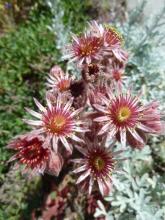
And Jovibarba hirta:
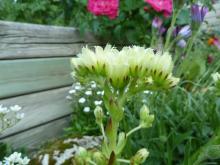
Re: Sempervivum
Some additions from me, too...
Jovibarba heuffelii and Sempervivum 'Bronco'
Sempervivum arachnoideum 'Minus'
April 29th shot of Sempervivum 'Robin' and S. arachnoideum 'Minus'
Re: Sempervivum
Lori, I know they aren't grown for the flowers, but I find them quite charming! They are putting on a good show here this year--most of my plants are still smallish, but I guess a lot of them reached maturity this year...
Rick--great colour especially on the April shots..nice big clumps, too..
A locally purchased S arachnoideum tomentosum.. when I bought this, I was sceptical about it being arach: the rosettes were large and open, and not that wooly--obviously grown in a greenhouse or some much milder climate (B.C.?) a couple years here they are small and tight as they should be...(more so in this overcrowded nursery pot.. I do find rosettes are much larger when first planted with lots of room.. no surprise, I guess..)
S x fimbriatum (behind) and S cv Rhodenicum in front; overview of the named semp nursery pot, with names..
Re: Sempervivum
Very nice trough photo, Rick.
Cohan, you have a very nice tapestry of colours going there too.
Re: Sempervivum
You've got a lot of flowering going on this year, Cohan! I also find the cobweb type hen and chicks to be variable, depending on the time of year and care. If you notice, even though my April pic of S. arachnoideum 'Minus' and the blooming shot are different plants, the habits are typical for the time of season here.
Speaking of tapestry, here's some nice "quilt work" from early May. You can easily pick out the two Sempervivum octopodes.
And a nice form of Sempervivum calcareum
Re: Sempervivum
Thanks, Lori-- they are a lot of fun, and don't mind this cold wet year at all :) Really need to get some division going in that crowded pot, though-- a couple small ones are disappearing!
Rick, I'm planning to put most of mine in the ground, but there's something about semps that look great in pots, so I think I will always keep some that way for fun, even though its a hassle with needing to be sunk for winter.. Nice calcareum! Def lots of flowering this year.. probably just old enough for those grown from small offsets in 2009 (just a couple of those flowered last year) and the arach tomentosum from local purchase seems to flower yearly, though we'll see what it does after so many stems this year...
Overall, they seem to enjoy the cool wet weather we've mostly had last couple of years, though I have one or two-- S altum notably, that don't seem to be thriving, and I wonder if they'd like to be drier/hotter--may try one in a small extra gritty pot...
Re: Sempervivum
This was said to be Sempervivum 'Excalibur'... it seems to fit the description below with respect to the offsets being on long stolons, at any rate (though not the colour description):
http://stalikez.info/fsm/semp/site/dwnld/ssj/ssj6_2.pdf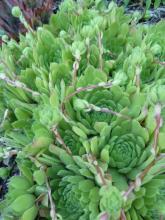
Re: Sempervivum
You have some nice collection of semps, all of you! When I started collecting semps, the first was Sempervivum tectorum which my grandma grew on the roof of the "jordkjeller" (= a small storehouse for vegetables, potatoes etc built into the ground and with soil on the roof). I didn't know that many species existed!
Re: Sempervivum
Speaking of tapestry, here's some nice "quilt work" from early May. You can easily pick out the two Sempervivum octopodes.
So are those offsets from your garden potted up for your NARGS chapter sales or... ?
Re: Sempervivum
So are those offsets from your garden potted up for your NARGS chapter sales or... ?
Yes, they were for the Chapter sale in early June. And then I accidentally left that whole flat at home the day of the sale! But it really wasn't missed. My pick up was filled with plants bound for the sale anyway.
Is there anything of particular note with S. thompsonianum?
Re: Sempervivum
Is there anything of particular note with S. thompsonianum?
Well, I think it's interesting due to the hairy tufts at the ends of the leaves, but it's all in the eye of the beholder.
Here's a report on it in habitat:
http://stalikez.info/fsm/semp/site/stogo_gb.php?lg=fr&clc=121&zc=Ae1f1aD...
Looking at photos, I'm not sure my plant even is this species now, though I thought I had pinned it down once previously.
Here are the flowers, which don't seem to fit that description:
http://nargs.org/nargswiki/tiki-browse_gallery.php?galleryId=20&offset=16
Any thoughts on what it might be?
Re: Sempervivum
So are those offsets from your garden potted up for your NARGS chapter sales or... ?
Yes, they were for the Chapter sale in early June. And then I accidentally left that whole flat at home the day of the sale! But it really wasn't missed. My pick up was filled with plants
Yes, I thought so. It was either that or new acquisitions.... lots of semps either way!
Re: Sempervivum
Is there anything of particular note with S. thompsonianum?
Well, I think it's interesting due to the hairy tufts at the ends of the leaves, but it's all in the eye of the beholder.
Here's a report on it in habitat:
http://stalikez.info/fsm/semp/site/stogo_gb.php?lg=fr&clc=121&zc=Ae1f1aD...Looking at photos, I'm not sure my plant even is this species now, though I thought I had pinned it down once previously.
Here are the flowers, which don't seem to fit that description:
http://nargs.org/nargswiki/tiki-browse_gallery.php?galleryId=20&offset=16Any thoughts on what it might be?
Sempervivum is one of several large and highly variable succulent/cactus genera that I don't really attempt to identify if they don't come with a solid id (apart from a few really distinct species)--so many species/varieties and hybrids!.. nice plant, anyway!
Re: Sempervivum
Recently came across the fantastic Kallima Garden web site. For semp fans, there an extensive listing (with excellent photographs) of 145 Semepvivum taxon and over 500 colorful cultivars. There are alpine pics here too. On the web page sidebar navigation, the semps are listed under "Rocky Roses", I assume a translation thingy. I just lost 2 hours on this site :o Enjoy.
http://kallima.sk/ekatalog.php?menuID=enk_semp&page=eabc_2.php&dbID=semp...
Re: Sempervivum
That is a good one indeed! Looks like I'm not getting anymore done today, Thanks! ;)
Re: Sempervivum
I particularly liked viewing the many forms of semp species, each collected from different locales... shows the species variability.
Here's another Semp information resource:
http://www.semperhorst.de/Inhaltsverzeichnis%20der%20HP/Inhaltsverzeichn...
Re: Sempervivum
Cruising around the internet looking at plant nurseries, I was surprised to see just how good the Sempervivum listing is at Edelweiss Perennials in Oregon. Since they maintain their connections to Europe and import plants from Europe, they have a number of unique and beautiful semps that are not typically available in the US.
Start here, there is 5 pages of semp species and cultivars:
http://www.edelweissperennials.com/PlantGroup.aspx?plant=Sempervivum
Note: at least with the browser I'm using (Internet Explorer 9.0), and the javascript used on the pages, the links often don't work, and I would need to let it "time out", use the back button, and then try each link a second time, where it usually worked. Have patience on the site, it is worth getting the pages to eventually load.
On their home page, at a glance you can shop by a number of specialty plant groups, their Epimedium listing is quite good too, among the lowest prices I'v seen for some "eppies".
http://www.edelweissperennials.com/index.aspx
Re: Sempervivum
As I've mentioned on a couple of other threads, though we've had a very mild winter by our standards, we've still had snow on the ground since early Nov, and in spite of a lot of weather from just above freezing to over 10C/50F, and lots of melting, there is still a lot of snow to go, and several of my beds are still partly to entirely covered..
So, its exciting to simply see plants emerging from the snow, nevermind growing or flowering! And Sempervivum/Jovibarba are good for this- they look interesting as soon as you can see them!
Last fall I made a new semp bed in front of the house, this one is nearly all plants received as 'lost label', so no names, but lots of colour; I'll be doing another bed somewhere else for named species..
I showed a few here already:
http://nargs.org/smf/index.php?topic=934.msg16138#msg16138
Some more, first from March 28, a partial overview; lots of debris on this bed- leaves and spruce needles blow to every part of our property, even far from the trees, and the dried grass and wood bits are there because this is in front of the house and got snow shovelled onto it all winter (wood from our constant firewood parade)..
Sempervivum ciliosum; this is in a large pot appended to the new bed.. The Veronica repens is impressive- bright green straight out of almost 4 months of snow cover.. it needs to be continually kept in check, but nice texture addition...
Then some shots from Apr 01
Re: Sempervivum
Nice to see your plants emerge from the cover of snow, Cohan!
Re: Sempervivum
Coming along nicely, Cohan. I just love that special form of Jovibarba allionii!
Mine is just green. I'm a lot farther along than you, and even more so in pots. Here it is with Orostachys aggregatum on the right. The orostachys has really jumped. It is completely deciduous (at least for me), so it is all new growth.
Sempervivum 'Robin' and a trough
Re: Sempervivum
Thanks, Trond- though some of my other beds are still under a foot or two of snow (driveway piles are still 2-4 feet, and there are some beds under those too) and we are under a winter storm warning for tomorrow- a couple cm in the afternoon possibly and another 15cm tomorrow night, with flurries or showers on thursday... we'll see what all that actually amounts to (some areas could see 20-30cm)
At the foot of that semp bed are some bulbs- crocus and galanthus just planted last fall- still no sign of emergence, though the snow only melted a short time ago at the bottom (and would still be there if I hadn't done some shovelling so it wouldn't stay waterlogged too long!) and the ground would still have been frozen solid when the snow melted (may still be!)
Rick- yes, much farther along! I do have a plant that has very similar colouring and texture to Robin, received as lost-label, but mine never opens up that much- a common theme in my climate, however! This is one effect of my nearly alpine climate I don't mind- the Semps tend to grow small and tight, though some are brave enough to open up in summer..
Are those Escobaria vivipara in the trough?
Re: Sempervivum
Rick-
Are those Escobaria vivipara in the trough?
Yes, grown from seed collected at the Minnesota/South Dakota border.
Re: Sempervivum
Nice ones :) I just have some tiny seedlings ..
Re: Sempervivum
Rick, the cacti fits very well with the semps! I have to try that at my summerhouse ;)
Re: Sempervivum
Rick, the cacti fits very well with the semps! I have to try that at my summerhouse ;)
I agree, Rick, that's a great looking trough, really like the S. arachnoidium type dangling some baby chicks.
The semps are plumping and coloring up here :)
Re: Sempervivum
Cohan, good to see that the snow has receded enough for some peeks at your semps, soon they will be plumping up and taking on strong color.
It is still a bit early for semps here, but they're starting to show color. In one of my planters in particular, Jovibarba heuffelii 'Gold Bug' is brightening up, as are the sempervivum neighbors. Here are a few early shots. The yellow and red-tinged one is the Jovibarba, the green and purple-brown tipped one is Sempervivum pittonii, and the amber red one is S. 'More Honey', a favorite.
Re: Sempervivum
Showing lots of color, Mark. You're right, that is Sempervivum arachnoides 'Minus' in my trough. In another couple weeks it will look like this:
And a month and a half or so, like this:
Re: Sempervivum
Looking good Mark and Rick;
Mark, really love the heuffelii, haven't tried any here yet....
We had another 15cm or so of snow wed night/thurs morning, and some more flurries last night.. semps are bare again already, though some other beds are still deep.. last night was -11C or so -quite impressive that these plants are already showing signs of life!
Re: Sempervivum
Finally managed to get some fairly accurate pics of some dark semps, they can be tricky to photograph! These are all from my plants received from Europe as 'lost-label', and planted in a new bed last fall after a couple of years in community pots..
Re: Sempervivum
I think these are the darkest I have ever seen!
Re: Sempervivum
They are dark ;D Of course it varies through the year, depending on conditions, and I'm wondering if it varies even on a smaller scale- after a day of scattered light showers, and more rain overnight, they seem slightly less dark today, though I didn't have time to really look.. next I have to capture some of the really red ones!
Re: Sempervivum
I like the pink ones :) You are just a little ahead of me- I have an arach in bud, along with ciliosum..
Re: Sempervivum
Sempervivum arachnoides 'Minus' has very small rosettes and is great for a trough. Blooming behind is Sempervivum 'Red Ace'.
Has anyone had this happen before?
Here you see normal stalked Red Ace flowers and one that has almost no stalk.
Re: Sempervivum
Has anyone had this happen before?
Here you see normal stalked Red Ace flowers and one that has almost no stalk.
Yes, it seems quite common to get nearly stalkless flowering on semps sometimes, not sure why. Here is Sempervivum 'Brock' with flowers developing right at rosette level, the photo taken today.
Also flowering, is S. pittonii, one of the better ones for flowers and stalks in proportion to the neat rosettes. It rarely flowers, so I'm happy to notice a couple stalkd today.
Noticed today that Sempervivum 'Noveau Pastel' is showing three rosettes that are going to bloom. This one almost never blooms. I might collect the seed and grow on seedlings on this one, there are so few semps with this coloration; all spring the warms tan-coffee brown color has been a delight, it is now turning a chartreuse-tan color. Behind it is Jovibarba heuffelii 'Torrid Zone' that is about to flower, this is perhaps the showiest of the heuffelii cultivars.
Rick, I said it before, but I'll say it again, I really like your refined trough with S. arachnoideum and others, including hardy cacti. :) Is the cross S. arachnoideum x S. pittonii one of your own making? I'd like to see what the rosettes look like.
Re: Sempervivum
You really have some nice semps, Rick and Mark. Mine have almost disappeared the last years due to invading grass and other plants, and flowering. Some seems to almost flower itself to death, like this one: (Sorry for the bad picture but my camera is dead and my wife's is out of power!)
Nameless as usual, but this time it isn't my fault. The semps for sale here have almost never names and many of my plants are old "heirlooms" without names too.
Regarding short flower stalks I have noticed that this sometimes happens when a rosette in vigour growth suddenly change mind and starts flowering in stead of continuing growth. The rosettes due to flower are usually initiated very early in spring.
Re: Sempervivum
Has anyone had this happen before?
Here you see normal stalked Red Ace flowers and one that has almost no stalk.Yes, it seems quite common to get nearly stalkless flowering on semps sometimes, not sure why.
Then I suppose breeders have already taken seed from these short anomalies in hopes of manifesting the trait, but without success. what a pity...
Rick, is the cross S. arachnoideum x S. pittonii one of your own making? I'd like to see what the rosettes look like.
No, I bought it just this spring. The company sent a few rosettes which I planted up, and they are still growing in a rather shaded location, so I am not sure the form (or color) is completely true. I had planted some starts of S. calcareum that are in the same conditions, so I took a picture of both, and had some photos of the same S. calcareum clone in other seasons that might give you a better idea of the cross's characteristics.
S. calcareum and S. arachnoides
Re: Sempervivum
Sempervivum 'Jestor' is aptly named with the apple green and red coloring. I think it is the best one I have for holding its colors in the adverse conditions of heat and drought stress.
Re: Sempervivum
Rick, don't they all keep some colouring during summer? Those I have do although I can't say we experience heat stress - drought maybe, but heat, what is that :-\
Re: Sempervivum
Trond, no heat stress here either, and no drought the last couple of years! Its pouring now, again, but supposed to be dry for a few days after this, and we may even hit 30C by monday- if so, it would be the first time this year...
My semps have kept good colour all year in these last few cool years- I haven't been back here for a warm dry summer yet- not sure if we will ever have one again ;D My dark reds are still very dark, and several are coming into flower now..
Rick, my S ciliosum, which flowered on something like 7 or more stalks last year (on fewer square inches than that) later in the season also produced some very short flower stems, below the still flowering tall stems; I figured those new ones just didn't have the energy anymore to be taller! amazingly, that clump of ciliosum totally filled in around those dead rosettes so you can't even see any gaps, and is flowering again this year on about 4 stems, impressive plants for monocarpics!
Mark, I like the brownish ones too, I have one tiny no name which is quite brown in spring, though less so in its summer colour...
Re: Sempervivum
Rick, don't they all keep some colouring during summer? Those I have do although I can't say we experience heat stress - drought maybe, but heat, what is that :-\
Actually Red Ace is also holding its color well here, but other mostly reds like Noir and Maigret are now mostly green. In general, I would say that all semps here change color from spring into summer. At least for me. I've always said I am not a very attentive grower of anything, and semps receive a lot of neglect. They are one of the last on my list to be sheltered from hot sun, since that space is rather limited. We are in our ninth day in a row with high temps in the mid 90's (35C) and lows above 70 (21C), with high humidity.
compare these photos of 'Robin' and 'Minus' in the left front corner of the same trough:
29 April
http://nargs.org/smf/index.php?action=dlattach;topic=182.0;attach=20252;...
25 June
http://nargs.org/smf/index.php?action=dlattach;topic=182.0;attach=34718;...
Re: Sempervivum
Most of my semps also change colour, though it may be a less extreme change- my semp bed still has lots of stron gcolour (I'll try to take some new pics today, then maybe some more next week after we are supposed to actually have some warm sunny weather).. there is also, for some, a strong change in form- ciliosum and arachnoideum don't change much- they stay tightly closed all year here, but others go from tightly closed to quite open....
My challenge is the opposite of yours- I have to think hard about what plants to give the few mostly fully exposed sites I have, and try to acquire plants which are okay with only a half day of sun, or better yet, dappled sun! I doubt heat stress is a factor for many plants here- even on the warmest days my nights are mostly cool- we have days of 28-30C forecast sunday to tues (82-86F and by far the warmest we've had this year) and the warmest nights are 10C/50F.. Today is only supposed to get to 13C/55F and tonight down to 2C/35F.. guess those coloured semps are in no danger...lol
Re: Sempervivum
Rick, your Sempervivum 'Jestor' is a nice lively color combination, I like it.
Looking around the garden today, I noticed how Jovibarba heuffelii 'Gold Bug' has changed into its summar garb, thick leaves of orangish-tan on the outer leaves, with a glowing lime center.
An updated view of Sempervivum 'Brock' with anomalous stemless flowering.
Sempervium ciliosum var. borisii in summer becomes eye-catching white-chartreuse in appearance, among my favorite species.
Jovibarba heuffelii 'Torrid Zone' (earlier I said this was 'Hot Lips', should depend more on labels than on memory), ready to flower, with S. ciliosum var. borisii on the left and S. 'Nouveau Pastel' on the right.
Re: Sempervivum
My challenge is the opposite of yours- I have to think hard about what plants to give the few mostly fully exposed sites I have, and try to acquire plants which are okay with only a half day of sun, or better yet, dappled sun!
Don't sweat it too much.... they're not fussy plants and will grow pretty well anywhere. I have some semps under trees where they don't get as much light as they might wish for, however, they do cover the ground and look decorative, nonetheless.
Re: Sempervivum
My challenge is the opposite of yours- I have to think hard about what plants to give the few mostly fully exposed sites I have, and try to acquire plants which are okay with only a half day of sun, or better yet, dappled sun!
Don't sweat it too much.... they're not fussy plants and will grow pretty well anywhere. I have some semps under trees where they don't get as much light as they might wish for, however, they do cover the ground and look decorative, nonetheless.
I wasn't thinking so much about the Semps, which are mostly growing like gangbusters ;D and because they are among my faves they are getting some of the best spots- right in front of the house where they can be appreciated the whole time they are not covered with snow!More so some other things that I might like to grow that I worry about enough light for, oh well! One can always try, and no site can grow everything :) I do, though, on seedlists, lean to things that say north or east slopes, or under shrubberies, forest clearings (a term that describes most of my gardening area!) or at least amongst other forbs and grasses.. a lot of semps in nature have those semi-sheltered spots too- with grasses around, edges of trees etc..
Re: Sempervivum
Some semps from today, these are mostly from the same batch received several years ago as lost label, and planted in ground last year
Re: Sempervivum
Well, Cohan, you have a nice collection there!
Re: Sempervivum
Thanks, Trond- that's not all of them, either! But I know compared to the real collectors, I have very few.. Some of them are quite prolific, too- I started with two small batches of tiny offsets I was sent several years ago, and I now have two new rock beds with mainly semps in them, and still have many leftovers in pots! I can already imagine the first bed, planted last year, will have little empty space between the plants in another year or two...
Re: Sempervivum
Thanks, Trond- that's not all of them, either! But I know compared to the real collectors, I have very few.. Some of them are quite prolific, too- I started with two small batches of tiny offsets I was sent several years ago, and I now have two new rock beds with mainly semps in them, and still have many leftovers in pots! I can already imagine the first bed, planted last year, will have little empty space between the plants in another year or two...
Looks good anyway and you do have some pebbles too ;)
I remember collecting stamps in my youth - I always had less than the real collectors - as with plants. Like here at the forum, it's always someone with more (and better) plants than yourself :o
Re: Sempervivum
And the serious collectors of course tend to be very focussed- I could never settle on one category of plants, let alone a genus ;D
Re: Sempervivum
And the serious collectors of course tend to be very focussed- I could never settle on one category of plants, let alone a genus ;D
I can never be serious either; not to talk about focussed ;D
Re: Sempervivum
I can never be serious either; not to talk about focussed ;D
What were we talking about? ;D
Re: Sempervivum
Sempervivum 'Rhodenicum'; photo taken Oct 04, 2012, our heaviest frost so far this year, -5 to -9C; this is in my new named Semp and Alpine rock garden, in front of the house..
Re: Sempervivum
Actually, the plant in the upper left caught my eye...
Re: Sempervivum
LOL- that's why I usually label my photos with every plant clearly visible in them- but I thought that one was far enough back to ignore! its a Polemonium boreale seedling.. I'll show some better pics in another thread...
Re: Sempervivum
I had probably not noticed it if you hadn't mentioned it, Rick!
Re: Sempervivum
A few more shots from a few days ago.. these are all planted in my new named semps etc bed in front of the house
1 Jovibarba (globifera) allioni Gorges Superieures de Cians, Fr
2 Jovibarba (globifera) hirta Belianske Tatry, Slovakia
3 Sempervivum x pomellii Chastel sur Murat, Fr
4 Sempervivum marmoreum erythraeum Pirin, Bulgaria
5 Sempervivum marmoreum erythraeum Pirin, Bulgaria
Re: Sempervivum
The only "rosularia" I ever had turned out to be Sedum pachyclados (!)
I am pleased to say that I now have a Jovibarba that rivals your luscious species form, Cohan.
Jovibarba allionii f./Esteng x J. hirta f./B. Karpaty
Sempervivum arachnoides 'Minus', putting on its winter coat.
Re: Sempervivum
Nice plants both of you have!
I am at my summerhouse at the moment, to do a job, but am disappointed when inspecting my plants. A herd of sheep has been grazing here all fall and damaged a lot. The owner does know about it but doesn't a damned thing about it >:( >:( >:(
Re: Sempervivum
That is a nice Jovi, Rick :)
Trond, sorry to hear, that's a tough situation, esp since you are not there full time :(
Re: Sempervivum
That is a nice Jovi, Rick :)
Trond, sorry to hear, that's a tough situation, esp since you are not there full time :(
Yes, I really am angry >:( I (and everybody else here) have talked to him several times and he always says he can't find out where the sheep (more like goats) escape (my niece found the place - they climb a steep rocky wall).
Re: Sempervivum
If he lives and farms there full time, it seems like maybe he does not consider part time residents with only display gardens very important..
Re: Sempervivum
If he lives and farms there full time, it seems like maybe he does not consider part time residents with only display gardens very important..
I think so - he actually lives on the next island and rents the fields of a farm on "our" island.
That does seem odd - can't
That does seem odd - can't say I've seen it!
Rick- at least your plant
Rick- at least your plant above had lots of offsets, so flowers or not, it should be good still :) I've had S ciliosum produce a lot of flowering stems, including some small ones like that, but can't say I looked closely enough to know whether they were from the same or multiple rosettes. The overall growth was so dense (packed in between rocks and pot edge) that the heavy flowering and subsequent rosette death, made little impact on the clump overall! I do have pieces of that clump in ground now (actually now it all is, the pot was disassembled, but that main chunk is still establishing) and initially they send out rosettes (still talking about ciliosum here) on longish -couple of inches from parent- surface stolons.. I guess it will start getting packed in when the open space between rocks is exhausted..
Here are a couple of views of plants just recently out of the snow-off and on!
Jovibarbas have to be some of the toughest plants in the rock garden re: low temps- I see some of them looking alert almost as soon as the snow is off, when nights are well below freezing still, and some of the days not much better.. this is a no-name plant, prob a J globifera form, in ground, then a potful of extra Jovis..

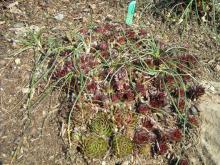
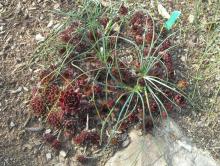
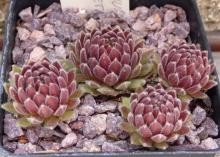
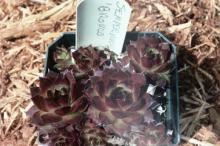
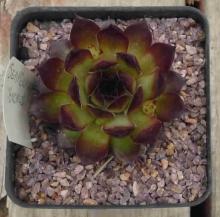
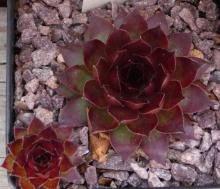
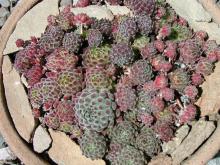
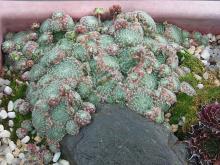
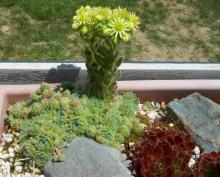
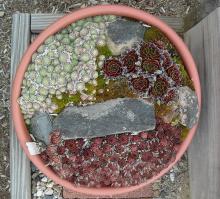

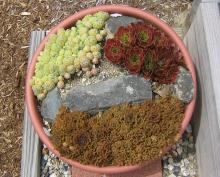

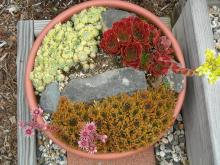
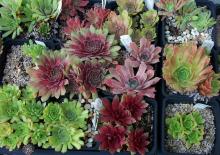
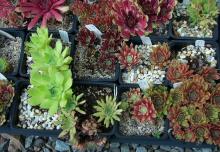
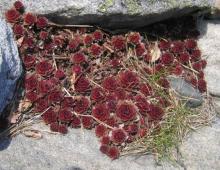
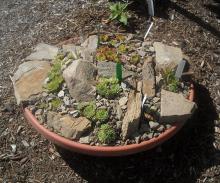
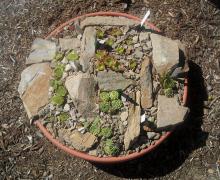
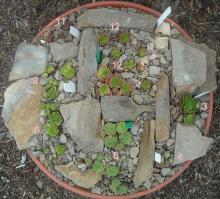
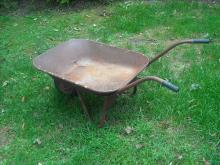

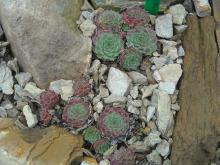
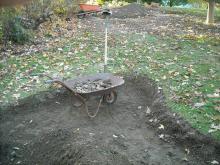
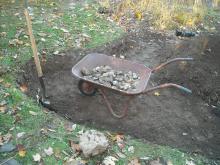
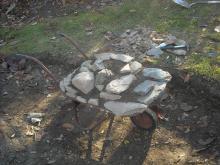
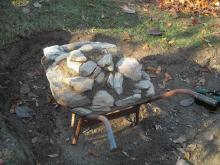
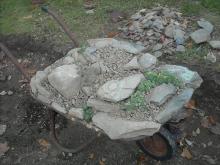
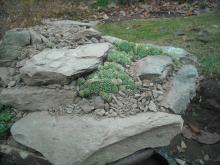
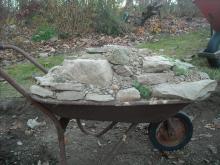
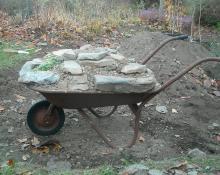
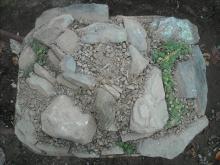
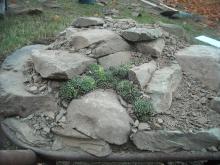
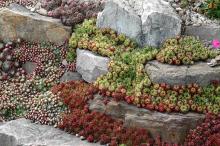
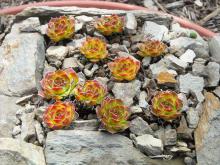
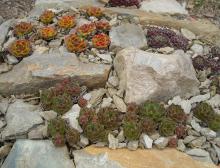


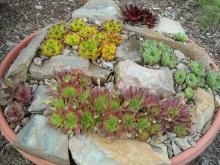


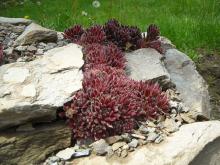
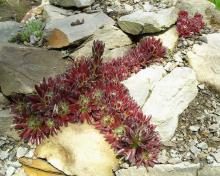
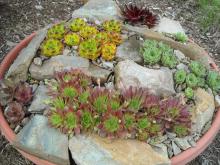
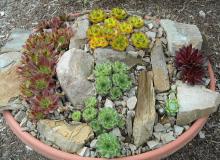
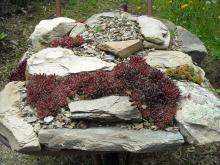
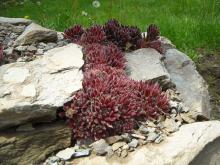
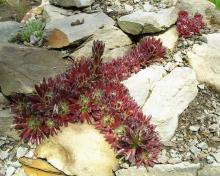
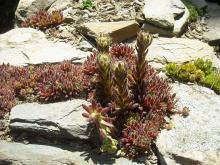
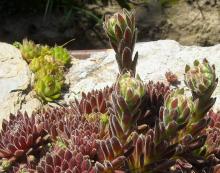
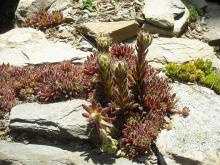
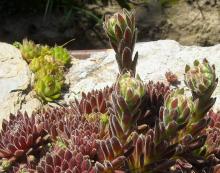
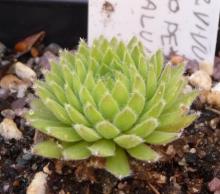
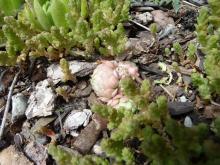
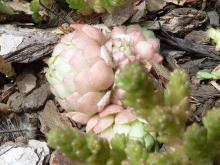
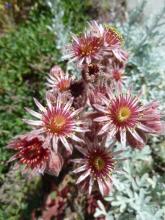

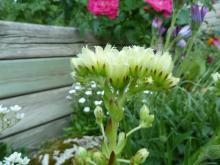
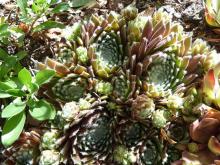
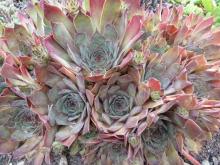
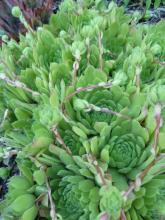
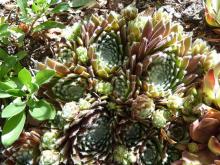
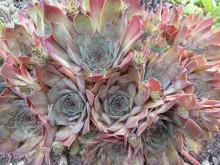

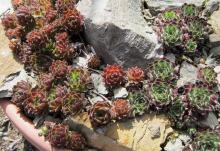
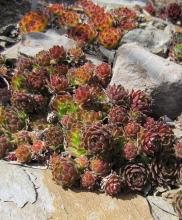
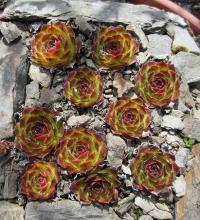
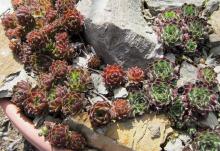
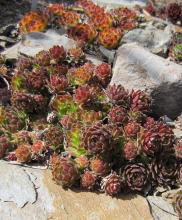
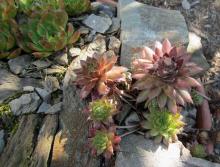

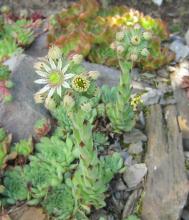


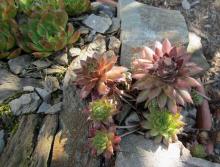
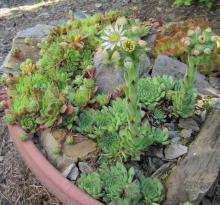
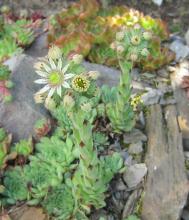
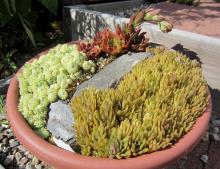

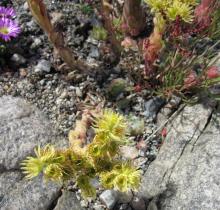
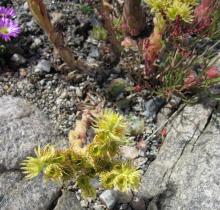
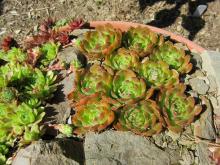
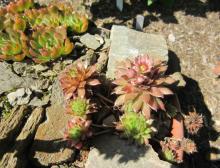
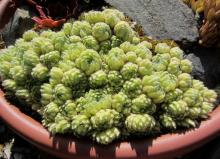

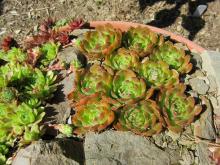
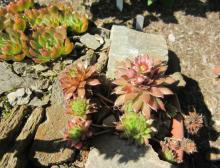
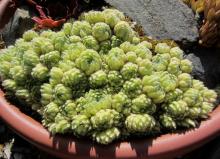

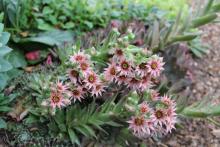

The following photo shows a sempervivum patch in the garden, illustrating two mistakes.
1. Alliums and semps don't mix! Allium seeds drop between the rosettes, a perfect home for seeds to germinate, and one ends up with this visual chaos, and it is near impossible to extract bulb seedlings. The allium in this case is A. flavum ssp. tauricum.
2. Most of the semp patch is a cultivar labelled 'Bronco'. I bought most of my semps in the days when reliable nursery sources for them existed, often nurseries run by semp hybridizers themselves, or nurseries with direct connection with such semp hybridizers. A couple years ago I bought a young plant labelled S. 'Bronco' at a plant sale, so I planted next to what I labelled as 'Bronco', but as you can see in the lower left corner of the patch, it is a different color semp, so is either one the true cultivar? It is a decade or more since the stars of Sempervivum hybridizing ended their activities, so getting true-to-name cultivars is more challenging than ever.
*Update: just dug out an Microsoft Access database I created to help track Sempervivum cultivars, and I find this for S. 'Bronco':
Hybridizer: Martin Haberer, 1977 "dark green lvs well edged & tipped dark purple", my plant purchased from Squaw Mountain (no longer in business)... so maybe the greener one in the lower left is the real McCoy?
Update #2: took a fresh photo, and in just a couple weeks, the greener rosettes colored up red similar to the main patch. Checking my label, I see that I bought the semp in 2005, a Sunny Border plant. I think I goofed up, when I planted the two cultivars together, thinking they were the same, one is 'Bronco' and one is 'Brock'. In the top photo, clearly the greener rosettes are larger and with more leaves in each rosette.